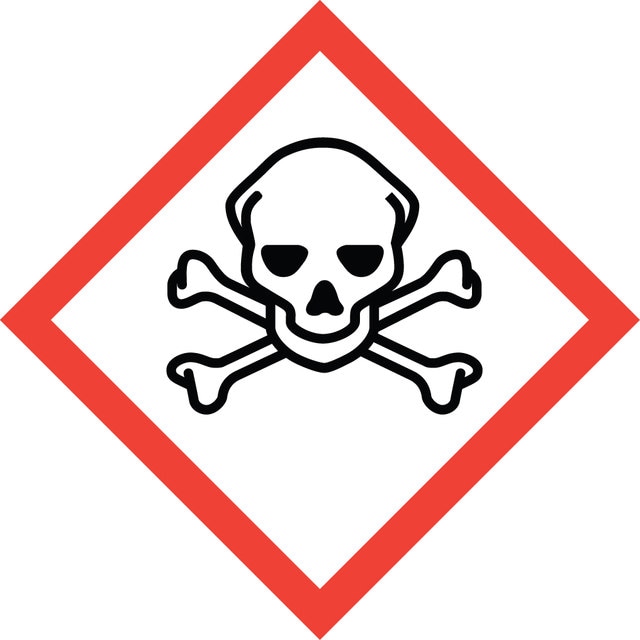Sign Into View Organizational & Contract Pricing
Select a Size
About This Item
Linear Formula:
(CH3)2C6H3NH2
CAS Number:
Molecular Weight:
121.18
Beilstein:
507414
EC Number:
MDL number:
UNSPSC Code:
12352100
PubChem Substance ID:
NACRES:
NA.22
Quality Level
Assay
98%
bp
226 °C (lit.)
mp
49-51 °C (lit.)
solubility
H2O: slightly soluble
alcohol: soluble
SMILES string
Cc1ccc(N)cc1C
InChI
1S/C8H11N/c1-6-3-4-8(9)5-7(6)2/h3-5H,9H2,1-2H3
InChI key
DOLQYFPDPKPQSS-UHFFFAOYSA-N
Looking for similar products? Visit Product Comparison Guide
Related Categories
Application
3,4-Dimethylaniline (3,4-DMA) has been used to study the electron donor-acceptor (EDA) interaction between 2,3-dicyano-1,4-naphthoquinone (DCNQ) and 3,4-dimethylaniline, in chloroform and dichloromethane. It can also be used for reactions with MoO(X)2(dtc)2 (X = Cl or Br; dtc = diethyldithiocarbamate) in methanol to form ionic imido complexes of the type [MoNAr(dtc)3]2[Mo6O19] or MoNAr(dtc)3]4[Mo8O26].
Signal Word
Danger
Hazard Statements
Precautionary Statements
Hazard Classifications
Acute Tox. 3 Dermal - Acute Tox. 3 Inhalation - Acute Tox. 3 Oral - Aquatic Chronic 2 - STOT RE 2
Storage Class Code
6.1A - Combustible acute toxic Cat. 1 and 2 / very toxic hazardous materials
WGK
WGK 3
Flash Point(F)
224.6 °F - closed cup
Flash Point(C)
107 °C - closed cup
Personal Protective Equipment
dust mask type N95 (US), Eyeshields, Gloves
Regulatory Information
新产品
This item has
Choose from one of the most recent versions:
Already Own This Product?
Find documentation for the products that you have recently purchased in the Document Library.
Gururaj M Neelgund et al.
Spectrochimica acta. Part A, Molecular and biomolecular spectroscopy, 78(1), 480-487 (2010-12-15)
The electron donor-acceptor (EDA) interaction between 2,3-dicyano-1,4-naphthoquinone (DCNQ) and 3,4-dimethylaniline (3,4-DMA) is studied in chloroform, dichloromethane and 1:1 (v/v) mixture of chloroform and dichloromethane. The rate of formation of the product was measured as a function of time using UV-vis
Martin Minelli et al.
Inorganic chemistry, 41(23), 5954-5960 (2002-11-12)
Anilines with alkyl substituents on the phenyl ring (ArNH2 = 2,4,6-trimethylaniline; 2,3-, 2,4-, 2,6-, and 3,4-dimethylaniline; and 2,6-diisopropylaniline) react with MoO(X)2(dtc)2 (X = Cl or Br; dtc = diethyldithiocarbamate) in methanol in the presence of 2 equiv of triethylamine to
Akito Takeuchi et al.
Journal of occupational health, 53(3), 230-233 (2011-03-23)
The purpose of this research was to develop a determination method for xylidines (XLDs) in workplace air for risk assessment. The characteristics of the proposed method, such as recovery, detection limit, reproducibility, and storage stability of the samples were examined.
Robert J Strife et al.
Journal of chromatography. A, 1216(41), 6970-6973 (2009-09-08)
The assessment of human exposure to specific isomers of dimethylanilines (DMA's) is of interest for the evaluation of potential exposure-health outcome relationships. Improved analytical methods will help in identifying the environmental sources of such exposures. The separation of all six
Tetyana Kobets et al.
Mutation research, 844, 10-24 (2019-07-22)
DNA-damaging activities of twenty-four structurally diverse unsubstituted and substituted cyclic compounds were assessed in embryo-fetal chicken livers. Formation of DNA adducts and strand breaks were measured using the nucleotide 32P-postlabelling (NPL) and comet assays, respectively. Unsubstituted monocyclic benzene, polycyclic fused
Our team of scientists has experience in all areas of research including Life Science, Material Science, Chemical Synthesis, Chromatography, Analytical and many others.
Contact Technical Service

